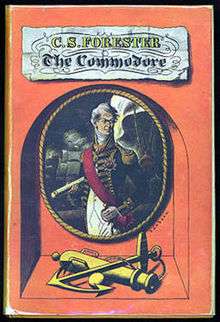The Commodore
 First edition cover | |
| Author | C. S. Forester |
|---|---|
| Country | United Kingdom |
| Language | English |
| Series | Horatio Hornblower |
| Genre | Historical novel |
| Publisher | Michael Joseph |
Publication date | 1945 |
| Media type | Print (Hardback & Paperback) |
| Pages | 272 pp |
| ISBN | 0-14-001116-1 |
| OCLC | 16550230 |
| Preceded by | Flying Colours (1938) |
| Followed by | Lord Hornblower (1946) |
The Commodore (published 1945) is a Horatio Hornblower novel written by C. S. Forester. It was published in the United States under the title Commodore Hornblower.
Plot summary
Having achieved fame and financial security, Captain Sir Horatio Hornblower has married Lady Barbara Leighton (née Wellesley) and is preparing to settle down to unaccustomed life as the squire of Smallbridge in Kent. He still yearns to serve at sea and accepts with alacrity when the Admiralty appoints him a commodore, puts him in command of a squadron and sends him on a diplomatic and military mission to the Baltic. His primary aim is to bring Russia into the war against Napoleon.
Hornblower is shown dealing with the problems of squadron command, and using naval mortars (carried on special ships known as bomb vessels) to destroy a French prize. This leads to the French invasion of Swedish Pomerania. Later his squadron calls at Kronstadt, where he meets with Russian officials, including Tsar Alexander I, who is favourably impressed by Hornblower and his squadron.
After Russia enters the war, Hornblower's squadron takes an important role in the defence of Riga, which is besieged by French forces. The bomb vessels again take an important role, and so do amphibious operations under the protection of the squadron. The siege is finally broken, and Hornblower joins the pursuit of the French armies on horseback, only to fall seriously ill with typhus.
During the siege and pursuit, Carl von Clausewitz, a German officer in Russian service, who is later to become famous as a military theorist and writer, is a character.
Ships
Hornblower's squadron
- HMS Nonsuch, 74-gun, Hornblower's flagship commanded by Captain Bush (Hornblower's former first lieutenant).
- HMS Lotus, a sloop, commanded by Commander Vickery.
- HMS Raven, a sloop, commanded by Commander Cole.
- HMS Harvey, a bomb ketch, commanded by Lieutenant Mound.
- HMS Moth, a bomb ketch, commanded by Lieutenant Duncan.
- HMS Clam, a cutter, commanded by Lieutenant Freeman.
Others
- Blanchefleur, a French privateer corvette
Notes
The novel occasioned some controversy when it was published. It appeared as a serial in the Saturday Evening Post, and Hornblower, in an implied sexual encounter with a (married) Russian Countess, was the Post's first adulterer. As Forester says in his Hornblower Companion, "...it really caused quite a flutter". Forester wanted to give Hornblower the opportunity to catch typhus, although he does comment that he believes that Hornblower caught typhus during the siege rather than in bed.
This book shows Hornblower's contrary character more strongly than many preceding books in the series. In particular, he is shown to be unable to be happy or self-satisfied in spite of accomplishments highly valued by others, including both professional and personal success. It also shows a growth of paternal feeling by Hornblower toward junior officers.
The historical accuracy of this book is limited: Forester later wrote that he did not know what British naval forces, if any, were engaged at the siege of Riga. (Historically they were commanded by Thomas Byam Martin.) Ivan Essen is presented as the governor of Riga throughout the campaign, but he was actually replaced by Filippo Paulucci delle Roncole a few months before victory was achieved. The date of publication (1945) reveals Forester's preoccupation in The Commodore—he parallels the political situation with that in the Second World War. In both cases, Russia was originally allied with a continental dictator (Hitler/Napoleon) but changed sides after being treacherously invaded. In both cases, Sweden remained neutral and traded with both sides. Russia similarly occupied other Baltic territories (Finland, Lithuania etc.) raising doubts about the correct response among the British government. In The Commodore (but not in the real Napoleonic period), as in the Second World War, the Royal Navy offered substantial help to Russia: at the siege of Riga, and by guarding the Arctic convoys. Less obviously, Forester draws parallels between the early 19th century and his own time in one or two of the other Hornblower novels.
In popular culture
In the Star Trek Deep Space Nine episode entitled "The Muse" (Season 4 Episode 21), the tablet computer that Jake Sisko uses to work on his story writing is actually displaying an excerpt from Chapter 1 Volume 9 of the Hornblower Saga.